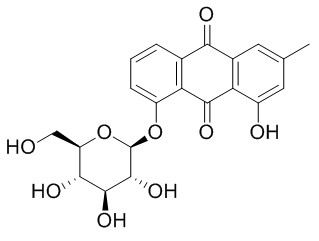Chrysophanol 8-O-glucoside
Chrysophanol-8-O-beta-D-glucopyranoside and chrysophanol have mild cytotoxicity and anti-diabetic properties and can play metabolic roles in the insulin-stimulated glucose transport pathway; it has potent inhibitory effect on collagen- and thrombin-induced platelet aggregation, it only inhibits platelet phosphatidylserine exposure.Chrysophanol-8-O-beta-D-glucopyranoside also exhibits significant anti-HBV activities with improved liver function, and enhanced HBeAg and HBsAg sero-conversion rates as well as HBV DNA clearance rates in HepG2 2.2.15 cells, DHBV models, or patients with chronic hepatitis B (CHB).
Inquire / Order:
manager@chemfaces.com
Technical Inquiries:
service@chemfaces.com
Tel:
+86-27-84237783
Fax:
+86-27-84254680
Address:
1 Building, No. 83, CheCheng Rd., Wuhan Economic and Technological Development Zone, Wuhan, Hubei 430056, PRC
Providing storage is as stated on the product vial and the vial is kept tightly sealed, the product can be stored for up to
24 months(2-8C).
Wherever possible, you should prepare and use solutions on the same day. However, if you need to make up stock solutions in advance, we recommend that you store the solution as aliquots in tightly sealed vials at -20C. Generally, these will be useable for up to two weeks. Before use, and prior to opening the vial we recommend that you allow your product to equilibrate to room temperature for at least 1 hour.
Need more advice on solubility, usage and handling? Please email to: service@chemfaces.com
The packaging of the product may have turned upside down during transportation, resulting in the natural compounds adhering to the neck or cap of the vial. take the vial out of its packaging and gently shake to let the compounds fall to the bottom of the vial. for liquid products, centrifuge at 200-500 RPM to gather the liquid at the bottom of the vial. try to avoid loss or contamination during handling.
FUTURE VIROLOGYVOL.2023, 18(5).
Pharmacognosy Magazine2018, 14(56):418-424
Foods2023, 12(23), 4342.
Sci Adv.2018, 4(10)
Molecules.2024, 29(6):1240.
Front Pharmacol.2022, 13:883475.
J AOAC Int.2024, qsae028.
Bioinformatics 2024, 586957
Molecules.2022, 27(4):1412.
Molecules.2018, 23(7):E1659
Related and Featured Products
J Pharmacol Sci. 2012;118(2):245-54.
Chrysophanol-8-O-glucoside, an anthraquinone derivative in rhubarb, has antiplatelet and anticoagulant activities.[Pubmed:
22302018]
Rhubarb is a widely used traditional medicine and has been reported to elicit a number of biological effects including anti-inflammatory and antiplatelet effects. In the present study, we investigated the effects of anthraquinone derivatives isolated from rhubarb on platelet activity.
METHODS AND RESULTS:
Of four anthraquinone derivatives isolated from rhubarb examined, Chrysophanol 8-O-glucoside (CP-8-O-glc) was found to have the most potent inhibitory effect on collagen- and thrombin-induced platelet aggregation. Chrysophanol 8-O-glucoside-treated mice showed significantly prolonged bleeding times. Furthermore, Chrysophanol 8-O-glucoside was found to have a significant inhibitory effect on rat platelet aggregation ex vivo and on thromboxane A(2) formation in vitro. In coagulation tests, Chrysophanol 8-O-glucoside did not alter prothrombin time, and it prolonged the activated partial thromboplastin time. However, Chrysophanol 8-O-glucoside only inhibited platelet phosphatidylserine exposure, but not exert direct inhibition on intrinsic factors.
CONCLUSIONS:
This study demonstrates the antiplatelet and anticoagulant effects of Chrysophanol 8-O-glucoside and suggests that this compound might be of therapeutic benefit for the prevention of platelet-related cardiovascular diseases.
Drug Discov Ther. 2013 Dec;7(6):212-24.
Traditional Chinese medicine and related active compounds: a review of their role on hepatitis B virus infection.[Pubmed:
24423652]
Over a long period of time in clinical practice and in basic research progress, the effectiveness and beneficial contribution of TCM on CHB have been gradually known and confirmed.
METHODS AND RESULTS:
Based upon our review of related papers and because of our prior knowledge and experience, we have selected some Chinese medicines, including Chinese herbal formulas (e.g., Xiao-Chai-Hu-Tang, Xiao-Yao-San, and Long-Dan-Xie-Gan-Tang), single herbs (e.g., Phyllanthus niruri, Radix astragali, Polygonum cuspidatum, Rheum palmatum, and Salvia miltiorrhiza) and related active compounds (e.g., wogonin, artesunate, saikosaponin, astragaloside IV, and chrysophanol 8-O-beta-Dglucoside(Chrysophanol 8-O-glucoside)) and Chinese medicine preparations (e.g., silymarin, silibinin, kushenin, and cinobufacini), which seem effective and worthy of additional and indepth study in treating CHB, and we have given them a brief review. We conclude that these Chinese herbal medicines exhibit significant anti-HBV activities with improved liver function, and enhanced HBeAg and HBsAg sero-conversion rates as well as HBV DNA clearance rates in HepG2 2.2.15 cells, DHBV models, or patients with CHB.
CONCLUSIONS:
We hope this review will contribute to an understanding of TCM and related active compounds as an effective treatment for CHB and provide useful information for the development of more effective antiviral drugs.
Biol Pharm Bull. 2008 Nov;31(11):2154-7.
Anti-diabetic properties of chrysophanol and its glucoside from rhubarb rhizome.[Pubmed:
18981591]
An ethanol extract of rhubarb rhizome exhibited marked glucose transport activity in differentiated L6 rat myotubes. Activity-guided fractionation resulted in the isolation of two anthraquinones, chrysophanol-8-O-beta-D-glucopyranoside (Chrysophanol 8-O-glucoside,1) and chrysophanol (2).
METHODS AND RESULTS:
The anti-diabetic effect was examined by glucose transport activity, glucose transporter 4 (Glut4) expression in myotubes, and the level of insulin receptor (IR) tyrosine phosphorylation as influenced by tyrosine phosphatase 1B, each of which is a major target of diabetes treatment. Chrysophanol-8-O-beta-D-glucopyranoside(Chrysophanol 8-O-glucoside) up to 25 microM dose-dependently activated glucose transport in insulin-stimulated myotubes. Increased tyrosine phosphorylation of IR due to tyrosine phosphatase 1B inhibitory activity with an IC50 value of 18.34+/-0.29 microM and unchanged Glut4 mRNA levels was observed following chrysophanol-8-O-beta-D-glucopyranoside(Chrysophanol 8-O-glucoside) treatment. Chrysophanol up to 100 microM exerted mild glucose transport activity and elevated the tyrosine phosphorylation of IR via tyrosine phosphatase 1B inhibition (IC50=79.86+/-0.12 microM); Glut4 mRNA expression was also significantly increased by 100 microM. The ED50 values of the two compounds were 59.38+/-0.66 and 79.69+/-0.03 microM, respectively.
CONCLUSIONS:
Therefore, these two anthraquinones from rhubarb rhizome, chrysophanol-8-O-beta-D-glucopyranoside(Chrysophanol 8-O-glucoside) and chrysophanol, have mild cytotoxicity and anti-diabetic properties and could play metabolic roles in the insulin-stimulated glucose transport pathway.



